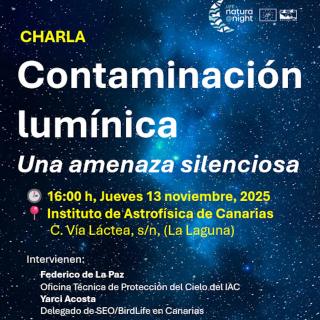It may interest you
-
 El Observatorio del Teide recibe este fin de semana a cerca de 1.000 visitantes en sus tradicionales Jornadas de Puertas Abiertas, organizadas por el Instituto de Astrofísica de Canarias (IAC) con motivo del solsticio de verano. Esta iniciativa, ya consolidada en el calendario divulgativo del IAC, ofrece a la ciudadanía la oportunidad de acercarse a la ciencia y a las infraestructuras científicas de Canarias de forma directa y cercana. La actividad está coordinada conjuntamente por el propio Observatorio y por la Unidad de Comunicación y Cultura Científica (UC3) del IAC, en el marco de lasAdvertised on
El Observatorio del Teide recibe este fin de semana a cerca de 1.000 visitantes en sus tradicionales Jornadas de Puertas Abiertas, organizadas por el Instituto de Astrofísica de Canarias (IAC) con motivo del solsticio de verano. Esta iniciativa, ya consolidada en el calendario divulgativo del IAC, ofrece a la ciudadanía la oportunidad de acercarse a la ciencia y a las infraestructuras científicas de Canarias de forma directa y cercana. La actividad está coordinada conjuntamente por el propio Observatorio y por la Unidad de Comunicación y Cultura Científica (UC3) del IAC, en el marco de lasAdvertised on -
 Especialistas abordarán el impacto de la iluminación artificial excesiva y sus efectos sobre la astronomía, la salud humana y la biodiversidad El Instituto de Astrofísica de Canarias (IAC) y SEO/BirdLife Canarias celebran la conferencia " Contaminación Lumínica: Una Amenaza Silenciosa", una jornada clave para la protección del medio ambiente y el patrimonio científico del archipiélago. La ponencia estará a cargo de Federico de la Paz, técnico del IAC, y Yarci Acosta de Seo/Birdlife, quien desgranará los graves riesgos que el uso ineficiente y descontrolado de la luz artificial supone para laAdvertised on
Especialistas abordarán el impacto de la iluminación artificial excesiva y sus efectos sobre la astronomía, la salud humana y la biodiversidad El Instituto de Astrofísica de Canarias (IAC) y SEO/BirdLife Canarias celebran la conferencia " Contaminación Lumínica: Una Amenaza Silenciosa", una jornada clave para la protección del medio ambiente y el patrimonio científico del archipiélago. La ponencia estará a cargo de Federico de la Paz, técnico del IAC, y Yarci Acosta de Seo/Birdlife, quien desgranará los graves riesgos que el uso ineficiente y descontrolado de la luz artificial supone para laAdvertised on -
 El Instituto de Astrofísica de Canarias (IAC) inaugura este miércoles 17 de diciembre una nueva edición del ciclo "Cosmoviaje 2.0. Lo que sabemos e ignoramos del Universo" y lo hará de la mano de la investigadora y directora del Museo de la Ciencia y el Cosmos Antonia Varela quien impartirá su charla " Observatorios de Canarias y sus descubrimientos" a las 16:15 horas. La entrada será libre y gratuita hasta llenar el aforo. Una experta de referencia en astrofísica y divulgación Antonia Varela es doctora en Astrofísica e investigadora del IAC, donde forma parte del Grupo de Calidad de Cielo yAdvertised on
El Instituto de Astrofísica de Canarias (IAC) inaugura este miércoles 17 de diciembre una nueva edición del ciclo "Cosmoviaje 2.0. Lo que sabemos e ignoramos del Universo" y lo hará de la mano de la investigadora y directora del Museo de la Ciencia y el Cosmos Antonia Varela quien impartirá su charla " Observatorios de Canarias y sus descubrimientos" a las 16:15 horas. La entrada será libre y gratuita hasta llenar el aforo. Una experta de referencia en astrofísica y divulgación Antonia Varela es doctora en Astrofísica e investigadora del IAC, donde forma parte del Grupo de Calidad de Cielo yAdvertised on